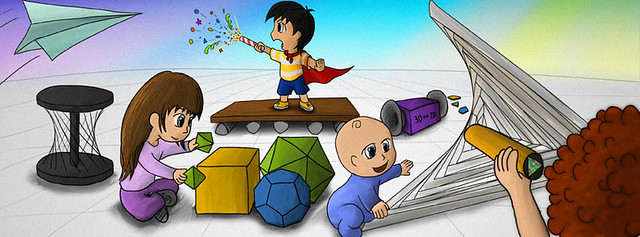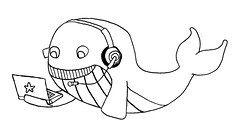Newsletter August 15, 2012

Welcome to adventurous math for the playground crowd! I am Moby Snoodles, and I love to hear from you at moby@moebiusnoodles.com

Moby’s mail
I adored the responses to our last newsletter. It feels good when your work is supported and appreciated. Take a look at these examples…
I love the 3D function machine drawing. It makes me think of a train going up and/or down a large mountain, and every time the train passes through a tunnel the number of cars increases (or decreases). Thanks for sharing. – Ryan M. Combs, M.S., HRD, Instructional Design, eLearning Development, First-Rate Human Being
- How interesting, Ryan! We actually have a picture of a train doing just that later in the chapter. What an interesting coincidence – or maybe the chapter’s front picture evoked the same image both in you and in Ever, our illustrator? Wow… – Moby S.
These newsletters are so beautiful, and so full of goodness, I’m delighted each time I read one. I see, though, that Moby must be struggling a bit with English grammar. (Is Moby’s first language whalish?) I’d be happy to be your final copyeditor/proofreader, to catch those just before it goes out. Warmly, Sue VanHattum, Math Mama Writes
- Thanks, Sue! I would love this! The newsletters go out twice a month. I can send you the text a few days before the letter goes out. – Moby S.
“Welcome to adventurous math for the playground crowd!” Love that. Is it alright if I use “adventurous math” and “playground crowd” in the future? I won’t make it a tagline, but those are brilliant turns of phrase. – Paul Salomon, Math Munch
- Thank you for your kind words! Yelena, the lead writer of “Moebius Noodles”, came up with this one. One of my favorite aspects of Yelena’s intrepid style is the bold, clear, but also metaphoric way she names entities such as math concepts, games, and in this case the main idea of the project. The whole project is Creative Commons, so you can share the motto too. I think it would be good if the idea of advanced math for the young kids – the playground crowd – spread as a meme! – Moby S.
Book news
One of the big challenges in making the “Moebius Noodles” book is the balance between three key types of the content.
- Mathematics. We need to introduce topic-specific math actions. Our topics are way beyond “counting and shapes.” Many of the readers, even adults, have never seen this math or never thought that its deep roots can be made accessible for young kids.
- Pedagogy. There are very few people in the world who work on making advanced math accessible to young kids. The lore on how to do it is far from being common knowledge. Last year at a conference in London, I met one of my pedagogy heroes, Richard Noss, who said it well: “Are you on the quest, too?”
- Well-being. We are inviting people, who often suffer from math anxieties, into adventures in uncharted territories. To help overcome fear and ease the anxiety, we provide some techniques for supporting cheerful disposition, mindful state of consciousness, and relaxed stance of the body.
Last week, we worked on games with grids. The mathematics of grids has to do with covariation between two aspects, organized along rows and columns of the grid. But young kids don’t see it this way. Pedagogical observation: young kids see each cell in the grid as a separate entity!
You can conduct an experiment to see this. Several parents told me this experiment is an eye-opener because it shows how different, and bizarre, the young mind really is. Offer a young child a printed or drawn grid and ask them to draw a copy. More often than not, children will draw each cell separately, often forgetting about row/column structure altogether.
Several of the “Moebius Noodles” games help kids see a row or a column as a whole, rather than as a collection of separate disjointed cells. This more advanced reasoning is a cornerstone of many concepts, such as multiplication. In grid games, it has to do with how you draw. Explaining a totally new concept of drawing, in words, to a very young kid, is a sure road to much frustration!
Our favorite well-being technique here is a mixture of kinesthetic guidance, caressing touch, and a tango where the child leads almost all the time. It looks like a parent drawing with the child’s hand. What you actually do is support the child’s own movements most of the time, but convey mild changes by slight hand pressure, so the child can follow your guiding hand as needed.
In the illustration, we tried to show all three aspects of the grid activity: the math, the pedagogy and the well-being technique. Here is a sketch, where you can see the typical kiddie “nongrids” in the background.
Our blogs
From the “math stories” department comes a story of cutting and folding.
The story I told my son was about three friends. He immediately made it about him and his two best buddies and how they were ninjas. Each friend was represented by a square of origami paper. We then folded each square, trying to predict what would happen to them after each fold…
We have been nominated for a top site award at the Circle of Moms. We entered the voting late (just a day before closing), though. If you know of a good lists of resources we should be trying to join, please let us know!
Talk to you again on August 30th!
Moby Snoodles, aka Dr. Maria Droujkova
Related Posts
Posted in Newsletter









Leave a Reply